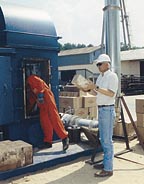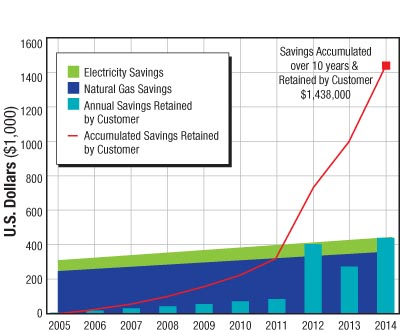Reducing Abatement Costs Using Performance Contracts

Typically, not much attention is given to the performance of an RTO unless a specific problem or fault shuts down the system or when the system is out of compliance. Opportunities to reduce the operating cost of an RTO by improving the energy efficiency are rarely considered. Because of the rapidly increasing cost of natural gas, the incentive to evaluate and improve RTO efficiency before any maintenance problems occur has never been greater. If the temperature rise across an RTO is around 140°F or greater, energy recovery projects usually can be justified based on the utility savings alone. An energy efficiency project may pay for itself, depending on the temperature rise and pressure drop across an RTO, the air volume being treated, and the annual hours of RTO operation. Other factors also may have an impact.
One major concern with any energy-saving project is the predicted savings vs. actual results. How can a plant be sure that the savings estimated during the project approval stage are realized after the project is completed? Are the predicted savings based on realistic assumptions? And more importantly, will the system continue to be operated at startup as well as in the foreseeable future in such a way that the savings are truly maximized?

Role of the Performance Contract
A performance contract is a tool that can be used to resolve these concerns and guarantee a reduction in RTO operating costs, with no capital investment required. The performance contract establishes the potential cost savings and guarantees savings.To set up and measure the details of a performance contract, natural gas and electricity meters are installed to measure actual utility consumption in an RTO (called "the baseline consumption") before the project begins. During plant downtime, some type of energy efficiency improvement is made to the RTO. Possible improvements may include the addition of catalyst, installation of natural gas injection or a more efficient ceramic packing. The plant pays nothing for the improvements. After the unit is restarted, the utility meters continue to measure the utility consumption. Once a month, the meter readings are used to determine the actual savings realized: the baseline consumption (i.e., what would have been consumed if no improvements had been made) less the actual consumption.
Under some contracts, the plant keeps the first portion of the savings, up to a guaranteed savings value. Savings above the guaranteed savings are paid to the contractor who installed the project, up to a predetermined savings target. Additional savings beyond the savings target are split between the plant and the contractor, often 50/50. When the contract expires, typically after four to eight years, the plant keeps all the improvements as well as all the savings.
Performance contracts feature strong advantages over simply purchasing and installing energy efficient projects. Most importantly, performance contracts make the contractor - not the plant - responsible for making the predicted savings a reality. Any shortfall in savings impacts the contractor only. The plant no longer has to evaluate how reasonable the assumptions or calculations are. That task is left to the contractor, who is the RTO expert.
The shared savings feature means it is in the contractor's best interest to periodically fine tune the system to minimize operating costs. The plant is assured of an efficient unit throughout the life of the contract. In most cases, the actual savings exceed the predetermined target savings, meaning the plant realizes savings greater than the guaranteed minimum, which lowers its costs even further.
Because the contractor is optimizing the system both at startup and throughout the life of the contract, the contractor is not simply taking a portion of the savings, he is actually increasing the amount of the savings.
An additional benefit of performance contracting is the side repairs. When the system modifications are being installed, it is relatively inexpensive to make other necessary repairs on items such as insulation and burners. Improvements to the system, such as valve or control upgrades, also can be funded by the savings guaranteed to the plant.
The most beneficial performance contracts are structured so it is in the best interest of both the plant and the contractor to do everything possible to maintain system performance at maximum efficiency. A well-structured performance contract places the plant and the contractor on the same side of the business equation.
Retrofits Provide Energy Savings
An example of a performance contract will show how it works and what it can do for the companies involved. This is an actual case study.After having installed three regenerative oxidation systems, a company that paints cabinetry learned that a "tune up" and ceramic media retrofit of the equipment could save them substantial energy costs. To do this, they contracted with Dürr Environmental and Energy Systems who ended up supplying a fourth unit as well.
The company, which is based in Ohio, operates several abatement systems, all of which are RTOs. The three that had previously been installed were all burning too much natural gas along with a substantial amount of electricity. While the equipment was meeting government standards, as the years went by they were consuming an increasing amount of energy.
Steve Blocki, general manager of Dürr, believes the company was wasting a lot of money. "We went in there with the goal of convincing them that it would really end up costing them nothing to overhaul the units based on the energy savings this would incur," Blocki says.
Salem Environmental had installed the existing regenerative thermal oxidation equipment. In 1998, Dürr purchased Salem. The RTOs are connected to several pieces of equipment, including spray booths and ovens, along with a range of smaller sources of pollutants. Over time, overspray from the paint booths contributed to plugging of the RTOs, resulting in a significant reduction in fuel efficiency. This is normal and occurs during the lifecycle of this type of equipment.
Blocki explained to the client that cleaning out as well as rebuilding the units with more efficient heat exchange ceramics would, in the end, not cost them any more money. "We (Dürr) created the savings and we took a portion of that savings as our payment. In return what we gave the client was complete maintenance services for the life of the contract (in this case, five years) that equated to having one of our people there 20 to 40 hours a week at no additional charge to them. In effect, they gained an in-house plant expert for the life of the contract at no additional cost. This was in addition to the complete rebuild of all four units," Blocki says.
The total cost savings was in the range of $1 million per year spread out over the four units. Most of those savings resulted from cleaning out the units and installing efficient heat exchange ceramics.
Natural gas and electricity meters were installed to measure actual utility consumption in the RTO (the baseline consumption). During plant downtime was when the improvements were made to the RTOs. After the unit was restarted, the utility meters measured the utility consumption. Once a month, the meters are used to determine the actual savings realized.
Typically in these types of reconditioning projects, the major components that get replaced include the ceramic media, media bed support structures, valves, burner components, fans and motors, PLCs and graphic displays, variable frequency drives, expansion joints and hydraulic and pneumatic systems.
Depending on the contract, the plant often keeps the first portion of the savings, up to a guaranteed savings value. Savings above the guaranteed savings are paid to the installer of the project, up to a predetermined savings target. When the contract expires, the plant keeps all the improvements as well as all the savings.
Companies are always looking for ways to save energy, and abatement equipment is a huge consumer of energy without value added to the product. Dürr's Total Solution program is unique because its payment is based on the energy savings that the customer realizes. Blocki says it is important that the customer understands that it is in both their best interest and Dürr's to generate cost savings through making the equipment as energy efficient as possible. "It places both [of us] on the same side of the business equation," Blocki says.
He also says that a good candidate for this type of program is one that has an old system that has become fuel inefficient. If a company is paying too much to run its abatement equipment, Blocki says, "It really comes down to getting a better, more efficient system without incurring any additional costs."
By using a performance contract, the company is not challenged to establish the payback; the provider is taking the risk.
Looking for a reprint of this article?
From high-res PDFs to custom plaques, order your copy today!




